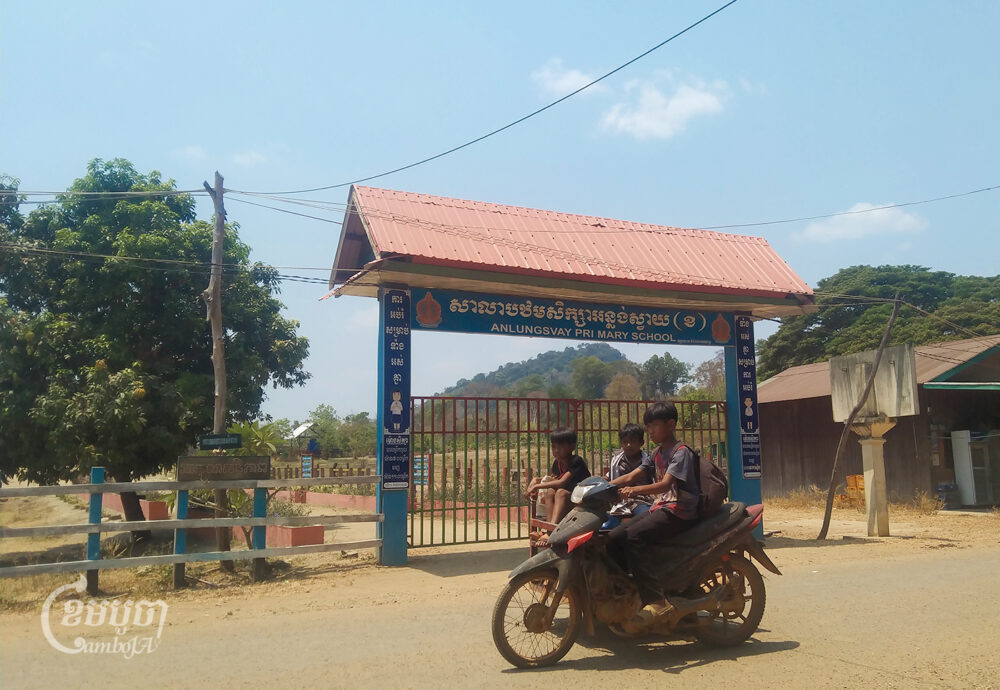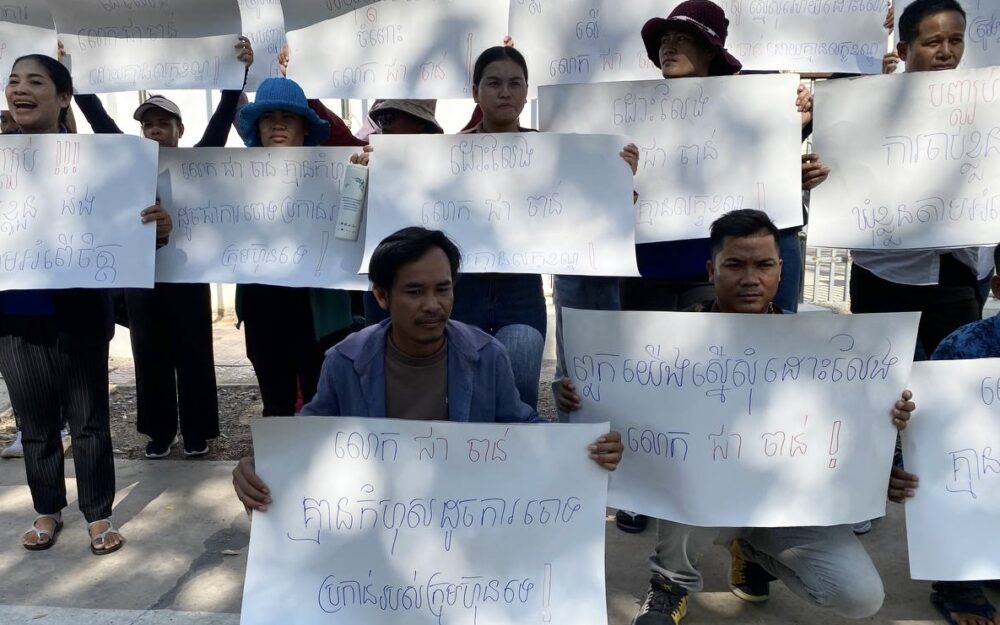Although the elementary school in Anlong Svay village is not far from the public area, it is quiet all around. A large number of children do not fulfill their educational goals to obtain a high school diploma. The main reason being the lack of teachers as well as a shortage of classrooms for higher grade students as the school is small.
Mich Phearom, a 27-year-old second-grade teacher, currently lives in Krala Peas village, Borey O’Svay Senchey district, and rides more than eight kilometers by motorcycles to school everyday. She said this is the reason why many cannot read and write.
Phearom said the problem stemmed from the children’s inability to speak Khmer, as they only conversed in Lao language. The children are not motivated by their parents to speak Khmer as parents themselves do not speak much Khmer. This is due to the proximity of the Laos border, prompting people to speak mostly in Laotian language.
In addition, children attend school irregularly because of transport problems where they have to travel between eight and 10 kilometers from home.
“A large percentage don’t come to school as they are not motivated. They do not pay much attention. Parents hardly encourage their children to go to school,” she said.
Anlong Svay Primary School, which has five rooms, is located in Preah Rumkel commune, Borey O’Svay Senchey district of Stung Treng province. It teaches pupils from kindergarten level to sixth grade.

Too far to travel
Thy Phearom, a 21-year-old Grade 6 teacher from Anlong Svay village is concerned about his students dropping out due to family issues and inability to read. Apparently, female pupils attend more regularly than male students.
Male students are not interested in school because they are distracted by mobile phones and a poor family background, which forces them to drop out of school to support their parents although they are only 13 or 14 years old.
Thy Phearom observed that a high percentage of parents opt not to enroll their children in kindergarten (elementary) school, preferring instead to start their children from Grade 1.
At the same time, teachers in Anlong Svay village are also challenged by insufficient teaching materials, a lack of cooling equipment, like fans, to stave off the heat during the dry season, inadequate books in the library, and the absence of a health room. These hinder the quality of education and the students’ overall well-being in the village.
“I would like to request study materials to teach students and fans for them as the months will become hotter and there aren’t enough fans. The campus is small and in some places there isn’t enough land. I also want the area to be clean. The library also lacks books and there is no health room yet,” he said.
Meanwhile, Man Netra, principal of Anlong Svay Primary School, told CamboJA that in 2022, there were 158 students in his school including 77 girls, in 2023 -158 students (70 girls), and 2024 – 163 students (88 girls).
He expressed concern over the high absenteeism rate owing to long distance travel and about five students who come by boat from an island.
Netra said to strengthen students’ learning, the cooperation of parents and a monthly discussion with them to ensure their support in encouraging their children to come to school regularly, are essential.
“I always meet with the children’s guardians. I sometimes go to their house which is far away from the village and urge their child to come. But he does not come because he is scared to travel far, ” he said.

Dropping out to work
One of the parents, Thy Thida, 28, who works as a food seller in the Anlong Phsot community, has three children in school. The first child is in seventh grade, while the second is in fourth grade and the youngest in kindergarten.
Expressing concern over her children’s studies, she was afraid that they were less likely to study further. She too studied up to sixth grade only. But, whenever she has some free time from work, she trains her children for half an hour.
“I wish to see the teachers teaching only one class [but] due to a shortage of teachers versus more students, some teachers have to teach two classes at a time. Some students focus less in class. I also wish the students would have English teachers,” Thy Thida said.
Another parent, Mon Navy, from the same community, said she noticed that her children were not studying well although they attended school regularly. As a mother who never went to school, she was worried that her children might end up illiterate.
“We want classes for all levels. We don’t want to send our children to study far away. Some who have money, send their children to other parts of the province. Some don’t have money and can’t afford to allow their children to continue their education,” said Navy, 38.
She also hoped that there would be English and Mandarin teachers. “I want my children to know Chinese too,” said the mother, who has one child in sixth grade at the Anlong Svay school and two others studying ninth grade in a pagoda.
Village chief Yann Suntak from Preah Rumkel commune, which covers eight villages, said most children do not finish high school. Some stopped at sixth grade and some at ninth grade, but in 2024, there will be classes for tenth grade students who want to continue their studies.
The 69-year-old told CamboJA that he was concerned about the number of dropouts at the school as many want to migrate to neighboring countries to earn a living for the family. He is also concerned about the increase in the number of people migrating every year.
He said there were more migrations among female students compared to male students. In 2022, there were 325 students, including 153 females, while in 2023, there were 158 female students out of 302 students. Some 310 students migrated in 2024, with 150 of them being female students.
A small number of undergraduate students migrated to neighboring countries. They were aged between 16 and 25. “Some have a prosperous life, so they continue to study in the province or migrate,” Suntak said.

Don’t have the budget
According to Chea Bunsang, director of the education office in Borey Svay Sen Chey district in Preah Rumkel Commune, schools in the area are impacted by budget constraints.
Despite requesting for more construction of school buildings to the Ministry of Education, Youth and Sport (MoEYS) each year, the budget remains small, therefore only one five-room building was approved in Sre Champa near the Lao border in 2024.
Seeking fast development to meet the needs of schools is not feasible because there are many schools, and the ministry’s budget is limited. It is not enough to fill the land in Anlong Svay Primary School, so the community helps to raise funds.
“The education office only helps to buy school materials, no budget to fill the land as the school yard is large,” he said.
Ty Thyda, deputy director of Stung Treng Provincial Education Department, said they have plans to deploy teachers across the province to address the needs of students who aspire to pursue 11th and 12th-grade education.
In particular, his department has proposed the construction of additional schools, which is among several requests made to the Ministry of Education, Youth and Sport, as well as funding.
The ministry offered scholarships to students to Preah Rumkel Secondary School, where 40 students, 27 of whom are female, received the financial aid between 2012 and 2015. Ten students were in 10 seventh grade with nine of them girls, grade eight (15 students) and grade nine (15 students).
“The department can’t help [Anlong Svay Primary School] because there are too many schools in the province [so] we cannot help much. The department’s budget has been reduced since Covid-19, so we don’t have any funds,” he said.
Cambodian Independent Teachers’ Association president Ouk Chhayavy said the education sector in Cambodia is not balanced. She observed that the government invests knowledge in densely-populated areas, but does not pay attention to remote areas. In fact, the education budget is limited even in areas, which are not even considered remote.
She is worried that if people continue speaking Lao more than Khmer language in Preah Rumkel, the national language, culture and customs might be lost in future.
“I want to encourage young people to acquire skills and knowledge so that thieves cannot steal it. They must have a deeper understanding of it,” she said.
A report by Unicef Cambodia showed that children in rural areas do not yet have standards that are appropriate for their age. At the primary level, nearly 25 percent of children in third grade cannot write a single word in a dictation test.
Only 27 percent of three to five-year-olds are developmentally on track in literacy and numeracy. By the time they turn 17, Unicef said 55 percent of adolescents will have dropped out of school.














